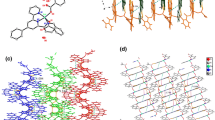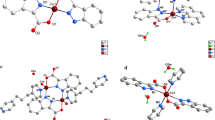Abstract
Two new 2D metal-organic complexes, namely [Cu(3-dpyb)(1,2,4-HBTC)(H2O)]·H2O (1) and [Cu3(3-dpyb)3(SIP)2(H2O)8]·6H2O (2) [3-dpyb = N,N’-bis(3-pyridinecarboxamide)-1,4-butane, 1,2,4-H3BTC = 1,2,4-benzenetricarboxylic acid, H3SIP = 5-sulfoisophthalic acid], have been hydrothermally synthesized and structurally characterized by elemental analyses, IR, TG, and single crystal X-ray diffraction analyses. Single crystal X-ray analyses reveal that the two Cu(II) complexes show different 2D coordination networks, the 4-connected (44·62) topology for complex 1 and the (4·62)2(42·62·82) topology for complex 2. In the 2D layers of complexes 1 and 2, the 3-dpyb ligands adopt a typical μ 2-bridging mode (via ligation of two pyridyl nitrogen atoms), while 1,2,4-HBTC and SIP serve as a linear spacer and a ‘V’-like linker, respectively, to connect the adjacent Cu(II) centers. The adjacent 2D layers are extended to 3D supramolecular networks via hydrogen-bonding interactions. The fluorescence properties of both complexes and electrochemical properties of complex 2 have also been investigated. The complex 2 bulk-modified carbon paste electrode (2-CPE) displayed a one-electron redox wave in potential range of 600–200 mV in 1 M H2SO4 aqueous solution, and 2-CPE showed good electrocatalytic activity toward the reduction of nitrite.




Similar content being viewed by others
References
Rieth S, Baddeley C, Badjić J (2007) Soft Matter 3:137–154
Tzeng BC, Chen BS, Yeh HT, Lee GH, Peng SM (2006) New J Chem 30:1087–1092
Ni J, Wei KJ, Min YZ, Chen YW, Zhan SZ, Li D, Liu YZ (2012) Dalton Trans 41:5280–5293
Yeşilel OZ, Günay G, Darcan C, Soylu MS, Keskin S, Ng SW (2012) CrystEngComm 14:2817–2825
Li JB, Dong XY, Cao LH, Zang SQ, Mak TW (2012) CrystEngComm 14:4444–4453
Cardellicchio C, Capozzi MA, Alvarez-Larena A, Piniella JF, Capitelli F (2012) CrystEngComm 14:3972–3981
Gua SJ, Huang JJ, Liu X, Liu HT, Zhou YS, Xu WL (2012) Inorg Chem Commun 21:168–172
Cui YF, Sun PP, Chen Q, Li BL, Li HY (2012) CrystEngComm 14:4161–4164
Zhang Y, Liu XG, Wang LY, Ding JG, Li BL (2012) Inorg Chem Commun 21:76–79
Chakrabarty R, Mukherjee PS, Stang PJ (2011) Chem Rev 111:6810–6918
Zhang KL, Hou CT, Song JJ, Deng Y, Li L, Ng SW, Diao GW (2012) CrystEngComm 14:590–600
Liu FJ, Sun D, Hao HJ, Huang RB, Zheng LS (2012) CrystEngComm 14:379–382
Sun HX, Xie WL, Lv SH, Xu Y, Wu Y, Zhou YM, Ma ZM, Fang M, Liu HK (2012) Dalton Trans 41:7590–7594
Zhao XL, Zhang LL, Ma HQ, Sun D, Wang DX, Feng SY, Sun DF (2009) RSC Adv 2:5543–5549
Li CP, Yu Q, Chen J, Du M (2010) Cryst Growth Des 10:2650–2660
Fang HC, Zhu JQ, Zhou LJ, Jia HY, Li SS, Gong X, Li SB, Cai YP, Thallapally P, Liu J, Exarhos G (2010) Cryst Growth Des 10:3277–3284
Liu QY, Yuan DQ, Xu L (2007) Cryst Growth Des 7:1832–1843
Su Z, Fan J, Okamura TA, Sun WY, Ueyama N (2010) Cryst Growth Des 10:3515–3521
Muthu S, Yip JHK, Vittal JJ (2001) J Chem Soc, Dalton Trans 3577–3584
Muthu S, Yip JHK, Vittal JJ (2002) J Chem Soc, Dalton Trans 4561–4568
Sheldrick GM (2008) Acta Crystallogr Sect A: Found Crystallogr 64:112–122
Lin HY, Hu HL, Wang XL, Mu B, Li J (2010) J Coord Chem 63:1295–1303
Yam VW, Lo KK (1999) Chem Soc Rev 28:323–334
Wang XL, Zhang JX, Liu GC, Lin HY, Chen YQ, Kang ZH (2011) Inorg Chim Acta 368:207–215
Acknowledgments
The supports of the National Natural Science Foundation of China (No. 20871022, 21171025), New Century Excellent Talents in University (NCET-09-0853), and the Natural Science Foundation of Liaoning Province (No. 201102003 and 2009402007) are gratefully acknowledged.
Author information
Authors and Affiliations
Corresponding author
Electronic supplementary material
Below is the link to the electronic supplementary material.
Rights and permissions
About this article
Cite this article
Lu, QL., Luan, J., Wang, XL. et al. Two new 2D copper(II) complexes constructed from a flexible bis-pyridyl-bis-amide ligand and two aromatic tricarboxylates: syntheses, crystal structures, fluorescence, and electrochemical properties. Transition Met Chem 37, 713–719 (2012). https://doi.org/10.1007/s11243-012-9642-z
Received:
Accepted:
Published:
Issue Date:
DOI: https://doi.org/10.1007/s11243-012-9642-z




